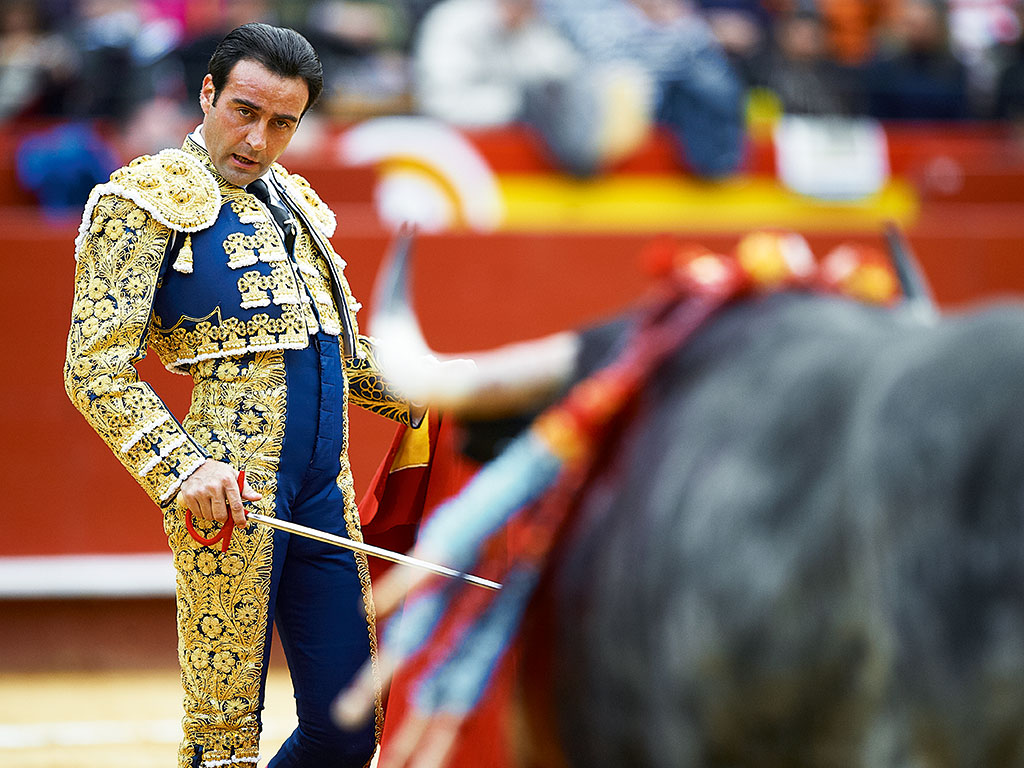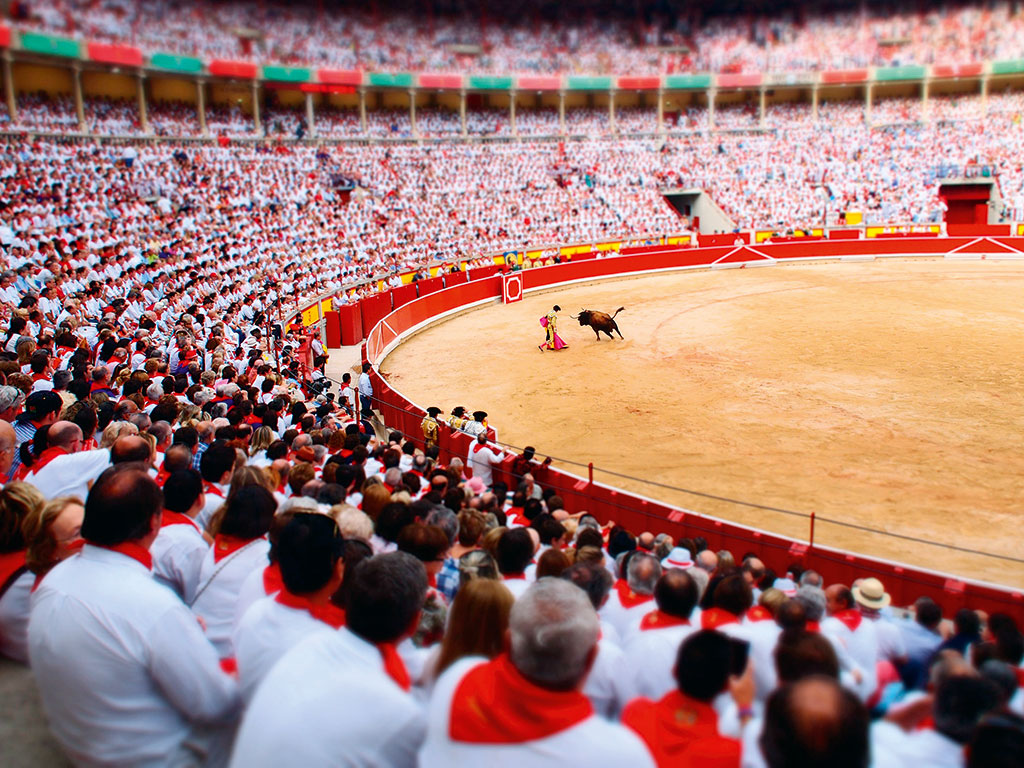
At the height of the Roaring Twenties, Ernest Hemingway was dragged into a lifelong love affair with what the Andalucían people call the corrida de toros. In the Anglo world, the sport is known by a far less amorous name: bullfighting. Today, 21st-century critics (of whom there are many) have campaigned tirelessly to see the cruel bloodsport banned entirely. Yet aficionados counter that it cannot aptly be described as a sport to begin with. Hemingway himself argued that bullfighting was more akin to a work of art – recognisable not by the senses, but rather by one’s primal perception of humanity and its domineering role in the wild.
“Bullfighting is the only art in which the artist is in danger of death and in which the degree of brilliance in the performance is left to the fighter’s honour,” Hemingway wrote. “It’s a great tragedy – and the most beautiful thing I’ve ever seen.”
Beauty is certainly in the eye of the beholder. Most outsiders tend to observe the displays of animal cruelty at the start of each fight in sheer terror, but in turn leave bearing a sombre blend of respect and inarticulate comprehension of the corrida’s underlying appeal. The pageantry of the matador and his cuadrilla is a pulsating display in and of themselves. Their vibrant costumes pay homage to a Spain long forgotten, while the matador and his muleta lull spectators into a trance as he dances around the fierce bull with indiscriminate grace.
Yet Hemingway didn’t view bullfighting as an art because of its lavish spectacle, instead he considered it a clear depiction of truth in a world of ever-increasing inauthenticity. The corrida, he said, was an all-too rare microcosm for life on earth in all its horrible and fascinating manifestations.
Matadors possess true afición – a genuineness that cannot be replicated in works of art that rely on aesthetics to convey power and meaning. To spiritual followers of the spectacle, the corrida offers a deeply ritualistic and symbolic insight into how man must draw from his cunning to overcome deep-seeded primordial fears. The fight sees two adversaries staring death in the face, before one accepts his fate and meets it valiantly. To true aficionados, this is a brief moment of existentialism amidst a society riddled with decay and falsities. To animal rights’ activists, it’s a bloody end to a sadistic, gladiatorial glorification of torture. To an extent, both portrayals are accurate.

The death third
The bullfight can trace its origins beyond ancient Rome and The Epic of Gilgamesh, however, the spectacle of corrida as the Spanish know it today is rooted in the sixteenth century. A typical fight lasts around 25 minutes, and is composed of three acts: tercio de varas, tercio de banderillas and tercio de muerte. In tercio de varas, the bull is released into the ring so the matador can observe its movements. Next, two picadores (lancers) enter the arena mounted on armoured horses and pierce the bull’s neck. The second stage, tercio de banderillas, sees three banderilleros enter the ring and attempt to plant barbed sticks into the bull’s shoulders – further weakening the animal and spurring it into ferocity. By the end of this stage, the bull has begun to bleed profusely. The final round inevitably seals its fate.
Tercio de muerte, the ‘death third’, sees the grand entrance of the matador, armed with only a sword and his colourful muleta. Whereas even serious fans of the spectacle will admit to the preceding two rounds being excessively cruel, the final act is one of tacit respect and mercy. The matador uses his muleta to attract the bull and waltz gracefully around it, the goal being to get as close as possible without being maimed. The dance effectively unites man and beast in a provocation of sheer splendour. That is until the series ends with the matador using his sword to stab the bull precisely between his shoulder blades and through the heart in a final pass. A skilled matador will typically put down the animal on his first try. If he fails, he’ll lose the honour and respect of his audience for an excessive display of butchery.
It’s not difficult to see why much of the world views the corrida as a bloodsport – in essence, it is. The industry sees tens of thousands of bulls – not just in Spain, but throughout Mexico and South America – farmed for the specific purpose of a drawn-out, public slaughter. Yet with regards to its classification as a sport, there are relatively few similarities. As in most typical western sports, professional bullfighting boasts a strict set of rules, as well as a cult following of fans. Stadiums have been known to attract tens of thousands for each fight, and spectators will jeer and taunt a matador who seems particularly lazy or inept. The corrida also pays homage to its ancient gladiatorial roots – in rare occasions, the crowd can request by popular demand that the bull be spared and released back into the field if he has ‘fought’ particularly well.
Today, arenas are still packed with crowds that quite accurately portray much of Spanish society. There are box seats for the rich, who raise the bulls and view the fights as imperative social events, while the stands are crowded with middle and working class families and tourists on a day out. As the economic climate in Spain continues to worsen, however, cheaper permutations of the corrida are becoming more popular than traditional bullfighting itself. For example, in the village of Tordesillas, up to 40,000 spectators have been known to gather to watch competitors simply spear a bull to death – with tickets up to 15 times cheaper than a traditional bullfight. Yet to the Spanish people in general, the proper corrida continues to represent a vital cultural distinction and a source of national pride. In this tradition, bullfighting is not a sport, but rather a form of art.

Underlying beauty
Although waning in popularity, bullfighting in Spain is still heavily covered in domestic media – but local papers tend to write about corrida de toros in their culture sections rather than the sports pages. Indeed, in some areas of Southern France, traditional bullfighting is now even protected under cultural heritage laws. So does it qualify as a sport? First and foremost, bullfighting is never advertised as a fair competition – it has never attempted to. In fact, it can neither be accurately portrayed as a fight, as the outcome is predefined. That’s the way it’s meant to be.
It’s a great tragedy and the most beautiful thing I’ve ever seen
Above all else, true aficionados don’t attend the corrida to quench their thirst for blood or pompous display, but rather to enjoy the event’s underlying beauty. Most tellingly, in a well-staged fight the crowd is totally silent and sombre throughout the first two acts of each corrida, in which the bull is mercilessly wounded. Some fans don’t even watch this part of the event at all. It’s only when the matador enters the ring that the arena comes to life. During this phase, the bull’s imminent death and unspoken valour speak to all who will listen. To merely read or speak about the final moment without first experiencing it does both the animal and the matador a gross disservice. At the core of bullfighting, each matador tells the story of humanity, and how in all its graceless splendour, it must cunningly overcome the atavistic dominance of the wild. This existential desire may be the true reason bullfighting advocates defend the sport so fervently. Not only does the corrida represent a vital aspect in Spanish culture, but this form of pragmatic living art appeals to virtually all walks of life. This is why matadors are still treated like celebrities in Spain, and the tradition has survived for so many centuries. The twenty-first century may not be so kind to the sport.
Tragedies end in demise
Hemingway argued that true art cannot exist without death, of course animal rights activists, and others besides, beg to differ. The agonising torture experienced by bulls that are born to be maimed is difficult to imagine. Most outsiders are unable to watch five minutes of a fight without being attacked by a crippling sense of remorse. Each ticket directly funds up to three hours of unwarranted butchery – and for many, this guilt is almost too much to bear.
Accordingly, regional governments and local councils have spent the last decade lobbying to see the spectacle eradicated from Spanish cities once and for all. One successful initiative has seen over 30 cities throughout Spain, Southern France and Central America make voluntary declarations to be ‘anti-bullfighting’ cities. The Catalan-based campaign has helped to raise awareness regarding the issue of animal cruelty associated with the corrida, and has since sparked more potent legislation in the form of an overall blanket ban throughout Barcelona and Catalonia. The Catalan ban came into effect at the beginning of last year; however, the move hasn’t heavily disturbed the bullfighting industry in general. After all, less than ten fights were held in Catalonia in 2011, versus almost 300 in Greater Madrid. Worse yet, cheap and artless public slaughters such as that in Tordesillas are completely and hypocritically unaffected by the ban. Bearing this in mind, it’s reasonable to assume that blanket bans aren’t necessarily effective tools with which to eradicate bullfighting, but are rather a mere legislative symbol illustrating the waning popularity of this dying art form.
One recent survey by Spanish newspaper El País found that 60 percent of Spaniards now strongly dislike bullfighting, while 72 percent have no interest whatsoever in the activity. Not only can this decline in popularity be pinned on the working class’ inability to buy pricey tickets to see fights, but research indicates interest in bullfighting is almost exclusive to over-45s. As this fan base continues to grey, the number of fights organised will inevitably decrease. In the past decade, the number of bullfights in Andalucía has fallen by over 50 percent. If popular support continues to decline at its current rate, the Spanish tradition of corrida de toros may not last the decade. Perhaps it shouldn’t.
The mysticism of the bullfight is one of cruelty and sadism. It embodies all that is wrong with humanity, yet serves to highlight some of the most redeeming qualities possessed by mankind: intelligence, grace, honour and mercy. In order to understand the true art behind bullfighting, one must first let go of their inhibitions and preconceived notions regarding morality – chiefly, the ethical treatment of animals. In this day and age, perhaps that’s simply too much to ask. Corrida de toros is beautiful, grotesque and everything in between, but even the most beautiful tragedies end in death and bullfighting is no different.

